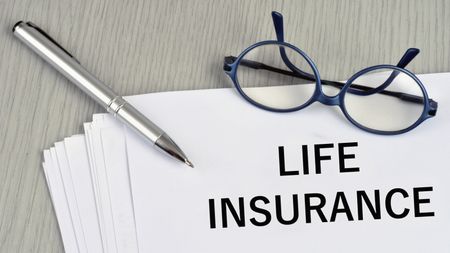Tapping the Cash in Life Insurance
Cash-value policyholders must consider taxes when they withdraw or borrow cash.

EDITOR'S NOTE: This article was originally published in the July 2009 issue of Kiplinger's Retirement Report. To subscribe, click here.
Like many retirees and workers approaching retirement, you may be holding a life insurance policy with a large cash build-up. As your needs shift from protection to income, it could be time to tap the assets, especially if the market decline has downsized your portfolio.
There are several ways to withdraw your money. Depending on your withdrawal choice, your death benefit could change -- and so can your tax liability.

Sign up for Kiplinger’s Free E-Newsletters
Profit and prosper with the best of expert advice on investing, taxes, retirement, personal finance and more - straight to your e-mail.
Profit and prosper with the best of expert advice - straight to your e-mail.
Ed and Carol Maier, of Frisco, Tex., bought life insurance soon after their son was born in 1973. The Maiers chose a Northwestern Mutual policy that offered a benefit beyond insurance coverage: a cash-value account that would grow over time. "This policy protected us if something tragic were to happen, and it provided a good way to build assets for retirement," Ed says.
Today, Ed and Carol are in their early sixties. They're more interested in the retirement-savings feature than the death benefit. Ed works part-time as a self-employed executive coach, but plans to cut back over the next ten years, when the policy's cash value will start to make a big difference.
At that point, the Maiers can make tax-free withdrawals up to the amount they've paid in premiums and can then borrow more money from the account. When they die, the loan amount will be subtracted from the death benefit, but their heirs won't pay taxes on the death benefit.
Unlike term insurance, cash-value policies, also known as permanent insurance, can continue for a policyholder's lifetime. It usually doesn't make sense for people in their fifties or sixties to buy a cash-value policy just to build up their savings. "It's a long-term investment," says Scott Berlin, senior vice-president in charge of individual life at New York Life. The cash-value policy works best, he says, if you can keep it for at least ten years before tapping it for retirement. At that point, much of the upfront fees have been paid and the cash value can really start to grow.
If you already hold a cash-value policy that you bought 20 or more years ago, your assets may have grown substantially. For instance, a 45-year-old man who paid $5,815 a year for a Northwestern Mutual policy with a $250,000 death benefit starting in 1989 would have nearly $208,000 in cash value in 2009. Meanwhile, his death benefit would have grown to nearly $430,000.
There are three main types of cash-value life insurance: whole life, universal life and variable universal life. The Maiers have a whole-life policy, the most traditional form of permanent insurance. You pay a fixed annual premium, and you're guaranteed a minimum cash value and death benefit every year.
Policyholders usually end up with more than the guarantee. The extra money comes from dividends, which are credited to policyholders based on the performance of the insurer's general account. During the policy's life, you can reinvest the dividends, use them to pay premiums or receive them in cash.
The Maiers reinvested all of their dividends and figure their account has grown by an average of 7.5% a year since they bought the policy. "We view it as a conservative, substantially risk-free investment," says Ed.
Universal-life policies are more flexible than whole-life insurance. You build up a cash value, but your premiums are not fixed. You can pay a bigger premium if you want a larger cash portion. At some point, you may have accumulated enough in your cash-value portion to cover the premiums.
The insurer usually promises that a minimum level of interest will be credited to the account every year -- 3% a year, for example. You may receive more if the insurer's chosen investments do well. (The cost of insurance and expenses are deducted from the account so you don't necessarily get a 3% return.)
With a variable universal-life policy, you can vary your premium yearly as you can with universal life. But the cash value is invested in mutual-fund-like separate accounts that you choose. There's usually no minimum guarantee and the cash value can change, depending on the funds' performance.
If you hold a universal-life or a variable universal-life policy, ask for an "in-force illustration" to make sure that your premiums still support the cost of insurance and expenses. Often, a company will charge a lower premium because it assumes that the cash value will cover some expenses. But if the account has lost value, the expenses may eat away at the cash value and the policy could lapse. You may need to boost your premiums to keep it in force.
Drawing the Cash in Retirement
Policyholders regularly receive statements showing the cash value. Note that any withdrawal will decrease your death benefit.
The tax-smart strategy for all of the policies is to first withdraw up to the amount you've paid in premiums. You will not pay any tax on that withdrawal. If you need more cash, you'll get the biggest tax savings if you take the additional money as a policy loan rather than as a withdrawal. You won't have to pay taxes on the loan as long as the policy is in force when you die. If you withdraw the money instead, you'll pay ordinary-income taxes on all of the gains above the premiums paid.
If you take a loan, your death benefit will decline. If you're already retired, it's probably not worth repaying the loan because you're unlikely to need a higher insurance amount. Also, you won't have many more years to benefit from tax-free growth in the account. When you die, the loan amount is deducted from the death benefit.
You need to keep close track of your remaining cash value, withdrawals and loans. In many cases, your premiums will be paid from the cash value. However, the increase in cash value is based on interest-rate and investment assumptions. If those assumptions are overly optimistic, there may not be enough money in the policy to cover the insurance costs. If the policy lapses while you have an outstanding loan, you could end up with a big tax bill.
Don't rush to take cash if you don't need it. There are no required minimum distributions from life insurance policies. The Maiers don't need the extra money right now, so they're continuing to reinvest the dividends as a way to boost the fixed-income portion of their overall portfolio.
The Consumer Federation of America's Evaluate Life Insurance service (www.evaluatelifeinsurance.org) can help you assess your options and figure out how much your policy is actually earning. The service costs $75 for the first illustration and $55 for each additional illustration.
For more authoritative guidance on retirement investing, slashing taxes and getting the best health care, click here for a FREE sample issue of Kiplinger's Retirement Report.
Get Kiplinger Today newsletter — free
Profit and prosper with the best of Kiplinger's advice on investing, taxes, retirement, personal finance and much more. Delivered daily. Enter your email in the box and click Sign Me Up.

As the "Ask Kim" columnist for Kiplinger's Personal Finance, Lankford receives hundreds of personal finance questions from readers every month. She is the author of Rescue Your Financial Life (McGraw-Hill, 2003), The Insurance Maze: How You Can Save Money on Insurance -- and Still Get the Coverage You Need (Kaplan, 2006), Kiplinger's Ask Kim for Money Smart Solutions (Kaplan, 2007) and The Kiplinger/BBB Personal Finance Guide for Military Families. She is frequently featured as a financial expert on television and radio, including NBC's Today Show, CNN, CNBC and National Public Radio.
-
 ‘Are You Better Off Than You Were 71 Days Ago?’ Cory Booker Marathon Senate Speech Highlights Tax Debate
‘Are You Better Off Than You Were 71 Days Ago?’ Cory Booker Marathon Senate Speech Highlights Tax DebateTax Policy A speech protesting Trump’s policies, including tax plans, breaks U.S. Senate records.
By Kelley R. Taylor Published
-
 Stock Market Today: Stocks Are Mixed Before Liberation Day
Stock Market Today: Stocks Are Mixed Before Liberation DayMarkets are getting into the freewheeling rhythm of a second Trump administration.
By David Dittman Published
-
 Roth IRA Contribution Limits for 2025
Roth IRA Contribution Limits for 2025Roth IRAs Roth IRA contribution limits have gone up. Here's what you need to know.
By Jackie Stewart Last updated
-
 Four Tips for Renting Out Your Home on Airbnb
Four Tips for Renting Out Your Home on Airbnbreal estate Here's what you should know before listing your home on Airbnb.
By Miriam Cross Published
-
 Five Ways to a Cheap Last-Minute Vacation
Five Ways to a Cheap Last-Minute VacationTravel It is possible to pull off a cheap last-minute vacation. Here are some tips to make it happen.
By Vaishali Varu Last updated
-
 How to Figure Out How Much Life Insurance You Need
How to Figure Out How Much Life Insurance You Needinsurance Instead of relying on rules of thumb, you’re better off taking a systematic approach to figuring your life insurance needs.
By Kimberly Lankford Last updated
-
 Amazon Big Deal Days Is Coming! We’ve Got All the Details
Amazon Big Deal Days Is Coming! We’ve Got All the DetailsAmazon Prime To kick off the holiday season with a bang, Amazon Big Deal Days runs Tuesday, October 8 and Wednesday, October 9.
By Bob Niedt Last updated
-
 How to Shop for Life Insurance in 3 Easy Steps
How to Shop for Life Insurance in 3 Easy Stepsinsurance Shopping for life insurance? You may be able to estimate how much you need online, but that's just the start of your search.
By Kaitlin Pitsker Last updated
-
 Five Ways to Shop for a Low Mortgage Rate
Five Ways to Shop for a Low Mortgage RateBecoming a Homeowner Mortgage rates are high this year, but you can still find an affordable loan with these tips.
By Daniel Bortz Last updated
-
 Retirees, It's Not Too Late to Buy Life Insurance
Retirees, It's Not Too Late to Buy Life Insurancelife insurance Improvements in underwriting have made it easier to qualify for life insurance, which can be a useful estate-planning tool.
By David Rodeck Published